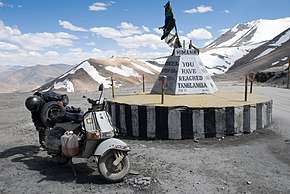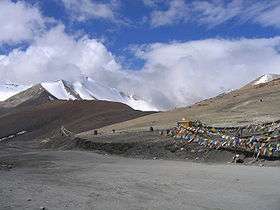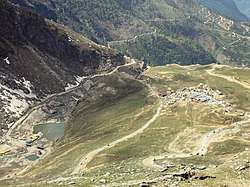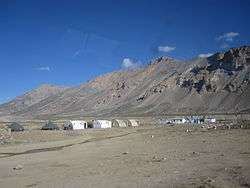Leh–Manali Highway
The Leh–Manali Highway is a 480 km (300 mi) long highway in northernmost India connecting Leh, the capital of the union territory of Ladakh, and Manali in the state of Himachal Pradesh. It is open for only about four and a half months in a year, from May or June, when the snow is cleared, and mid-October, when snowfall again blocks the high passes. It connects the Manali valley to the Lahaul and Spiti valleys in Himachal Pradesh and the Zanskar valley in Ladakh.
| Leh-Manali Highway | |
|---|---|

| |
 Taglang La pass, Elevation: 5359 m (17,582 ft) | |
| Route information | |
| Length | 479 km (298 mi) |
| Major junctions | |
| North end | Leh, Ladakh |
| South end | Manali, Himachal Pradesh |
| Location | |
| States | Himachal Pradesh, Ladakh |
| Primary destinations | |
| Highway system | |
The Leh–Manali Highway was designed and built and is maintained by the Border Roads Organisation (BRO) of the Indian army. It supports the heaviest army vehicles.
Geographical features
The average elevation of Leh-Manali highway is more than 4,000 m (13,000 feet)[1] and its highest elevation is 5,328 m (17,480 ft) at the Taglang La mountain pass. It is flanked by mountain ranges on both sides, featuring stunning sand and rock natural formations.

The highway crosses many small streams of ice-cold water from snow-capped mountains and glacial melts without a bridge and it requires driving skill to negotiate fast-flowing streams. The landscape changes immediately after getting past the Rohtang Pass and entering the Chandra river valley in the Lahaul region that lies in the rain-shadow. The greenery on the southern side of the mountain pass disappears and the mountain slopes on the leeward side become brown and arid. However, the mountain peaks are covered in snow and shine brightly in the sun.
The Leh-Manali highway is generally two lanes wide (one lane in each direction) without a road divider, but has only one or one and a half lanes at some stretches. It has over a dozen Bailey bridges, some in poor condition. The highway has many damaged stretches and under-maintained portions, where even a little rainfall can trigger dangerous landslides. The road quality is poor in many places and high speed can cause discomfort.
Length of highway
The total length of the highway is about 480 km (300 mi), 225 km (140 mi) in Himachal Pradesh and 255 km (158 mi) in Ladakh.[2] The state line is at Sarchu. The length in Himachal Pradesh will shorten by about 46 km (29 mi) when the Atal Tunnel is opened in 2020, avoiding the Rohtang Pass.
Distances
In Himachal Pradesh:
- 1: Manali (altitude 1,950 m (6,400 ft)) to Marhi at 3,300 m (10,800 ft) elevation 33 km (21 mi). It is a steady climb.
- 2: Marhi to Rohtang Pass at 3,980 m (13,060 ft) elevation 18 km (11 mi). It is a steady climb.
- 3: Rohtang to Gramphu at 3,200 m (10,500 ft) elevation 19 km (12 mi). It is a steady descent. Turn left (towards west) at Gramphu on the highway along Chandra river to proceed towards Leh. The right turn (towards east) at Gramphu leads to Spiti valley and Batal, Kunzum La and Kaza on a road along Chandra river that is paved for some distance and then unpaved.
- 4: Gramphu to Kokhsar, the first village north of Rohtang Pass. 6 km (3.7 mi). Foreign nationals have to show their passports with valid visa at the police check post here.
- 5: Kokhsar to Sissu at 3,130 m (10,270 ft) elevation 15 km (9.3 mi). The highway runs along the left (south) bank of the Chandra River, with a beautiful waterfall on the other side of the river. There is a helipad at Sissu with service to Manali during the winter.
- 6: Sissu to Tandi at 2,570 m (8,430 ft) elevation 17 km (11 mi). Tandi is at the bottom of a river valley, where the Chandra River and the Bhaga River (flowing from the north) merge to form the Chandra-Bhaga river (which becomes the Chenab downstream in Ladakh). Cross the Bhaga river over the bridge towards the right, take the right turn at the fork, and the road again starts climbing.
- 7: Tandi to Keylong at 3,080 m (10,100 ft) elevation 8 km (5.0 mi).
- 8: Keylong to Jispa at 3,310 m (10,860 ft) elevation 22 km (14 mi). Jispa is a village where two nullahs (small streams) join the Bhaga River.
- 9: Jispa to Darcha at 3,360 m (11,020 ft) elevation 6 km (3.7 mi). All tourists have to register at the police check post here.
- 10: Darcha to Zingzingbar 4,270 m (14,010 ft) elevation 26 km (16 mi). The steep ascent to Baralacha La starts at Zingzingbar.
- 11: Zingzingbar to Baralacha La pass at 5,030 m (16,500 ft) elevation 22 km (14 mi). It is a steady climb.
A stream (from a glacial melt) flows across the highway just after Zingzingbar. It is advisable to cross the stream before noon because the flow of ice-cold water increases as the temperature rises. If the flow of water is too powerful for a vehicle to cross, or if the weather worsens en route to Baralacha La, turn back to Zingzingbar or Darcha, and seek accommodation before trying on the next day. - 12: Baralacha La to Bharatpur 6 km (3.7 mi). It is a steady descent. The Bhaga river and the Chandra river originate from melting snow at opposite sides of Baralacha La, the former flowing southwest and the latter flowing first southeast and then northwest to merge at Tandi.
- 13: Bharatpur to Sarchu at 4,300 m (14,100 ft) elevation 28 km (17 mi). Sarchu is a military base and has a police check post. Register at the police check post here.
In the union territory of Ladakh:

- 14: Sarchu to Pang 4,600 m (15,100 ft) elevation 77 km (48 mi) climbing 500 m through the Gata loops (22 hairpin bends) at 4,190 m (13,750 ft) elevation and traversing through Nakee La pass at 4,739 m (15,547 ft) and Lachulung La pass at 5,065 m (16,616 ft) elevations. Register at the check post at Pang.
- 15: Pang to Taglang La pass at 5,328 metres (17,480 ft) elevation, 66 km (41 mi). This stretch crosses a plateau at 4,700 m (15,400 ft) called the More plains or Morey plains.
- 16: Taglang La pass to Upshi 61 km (38 mi). The highway crosses the Indus river to reach Upshi village on the north.
.jpg)
- 17: Upshi to Karu 14 km (8.7 mi) After crossing the Indus river at Upshi, the highway bears left for Karu. The right turn is an ancient trading road heading east toward Pangong Lake and Tibet. There is a helipad on this road.
- 18: Karu to Leh at 3,500 metres (11,483 ft) elevation, 35 km (22 mi) Staying to the left and following the Indus River leads toward Leh. There is another turn-off to the right that goes to Shyok, Pangong Lake, and Tibet.
Visiting some locations beyond Leh requires special permission, which can be obtained at Leh.
The distance from Lachulung La to Taglang La is 87 km (54 mi) via Pang.
Travel time
The journey from Manali to Leh normally takes two days, but can take longer depending on the road and vehicle. (Overnight accommodations are described below.) Travel time is unpredictable since the weather and road conditions can change suddenly. The Leh-Manali highway has bad stretches of roads and occasional landslides. It traverses mountains at over 5,000 metres.
The peak travel season is during May and June, when tourists visit Rohtang Pass. Most domestic tourists return to Manali and do not cross north of the pass. The Himachal Road Transport Corporation (HRTC) and the Himachal Pradesh Tourism Development Corporation (HPTDC) both operate buses that travel the entire highway in two days.[3] Buses start from Manali north at 4 am and after every two hours or so until 12 noon. The time to Keylong is 4 to 10 hours depending upon the condition of the road. Traffic jams may occur at Beas Nallah near Marhi and again at Rohtang Pass.[4] It is advisable to cross Rohtang Pass before 8 am.
Private four-wheel drive taxis are available. Shared taxis are cheap as they charge per person, but they may be full of local residents who will prevent good views of the scenery outside. The tourist cannot stop either a bus or a shared taxi for sightseeing. Some tourists travel from Manali to Leh and elsewhere in Ladakh on motorcycles, generally in a group.
Road surface

Snow and rain can make the highway slushy or too slippery to travel. Past precipitation can also create travel hazards. Much of Rohtang Pass remains covered by snow even in summer. Adjacent glaciers melt (more so as the day wears on) and water overruns the highway in many places. This water is ice-cold and travellers should avoid situations where they might have to wade through it.
Fuel stations
There are no fuel stations in the final 365 kilometres (227 mi) between Tandi and Leh. Vehicles should fill up at the start of this stretch, and motorcycles and vehicles with small tanks should carry additional fuel in cans. In an emergency, fuel may be available at small towns en route (Sarchu, Pang, etc.), but this fuel may be adulterated.
Altitude sickness
At high altitudes, the air is thinner and contains less oxygen. Acute mountain sickness is possible, whose symptoms include headache, nausea, dizziness, and vomiting. It can be fatal. If reaching the area by air from lower terrain, the traveller should acclimate to the high altitude by staying at least one night at the starting point (typically Manali), and plan to stay over at either Keylong, Jispa or Darcha before ascending to the highway's highest passes and plains after Darcha. Travellers should minimise the time spent at the high altitudes and therefore not stay over at Sarchu or Pang. They should carry chocolates, glucose or other high-energy food on the journey.
Climate

Ladakh is a cold semi-arid desert. It is cold along the highway even in summer (June onwards); the days are warm in bright sunshine but the nights are very cold. Light woollens are required during the day and thick woollens are required at night. There is no rainfall between Rohtang Pass and Leh even during the monsoon season in July–September as the entire region lies in rain shadow.
Accommodations

In India, a dhaba is a roadside eatery with low prices and no frills. These are found at some otherwise uninhabited places along the highway. Dhabas are not motels, but many let customers lie down and rest, and some can provide an inexpensive dormitory bed (without private toilet).
There is a variety of hotels to suit all budgets at the highway's endpoints, Manali and Leh. There are also hotels and PWD rest houses at Sissu and at Keylong (a district headquarters). There is one luxury hotel at Jispa.

Guesthouses are available at Jispa, Karu, Kokhsar village, and Upshi.
The remaining option is to sleep in a tent. These are generally basic and inexpensive, though luxury tents (Swiss-cottage tents) exist in Jispa and Sarchu. Some dhabas offer basic tents. Tent accommodations are available in Bharatpur (below Baralacha La pass, inhabited only during tourist season), Darcha, Jispa, Pang, and Zingzingbar.
References
- Series U502, U.S. Army Map Service, map of quadrant ni-43-12
- "Hundreds stranded on Manali-Leh highway". The Hindu. 23 September 2008.
- Dheeraj Sharma (15 July 2019). "Manali to Leh Bus Service - Timings, Rates & FAQs". DevilOnWheels.com. Retrieved 22 July 2019.
- ANI (16 June 2019). "4-km long traffic jam on Manali-Leh highway". Times of India.
External links
- Leh–Manali Highway on OpenStreetMap
- Mountain Passes along the route
- Riding on the Manali-Leh route
- Leh-Manali Highway
- Manali-Leh Highway on Bikemap (with GPS-track)
- Photos of a bike tour along the Highway from 1996.
- Ladakh detailed map
- U.S. Army Map Service
- Manali to leh motorcycle tour map
- 55 Spectacular Pictures of Leh Manali Highway
| Wikimedia Commons has media related to Leh–Manali Highway. |


